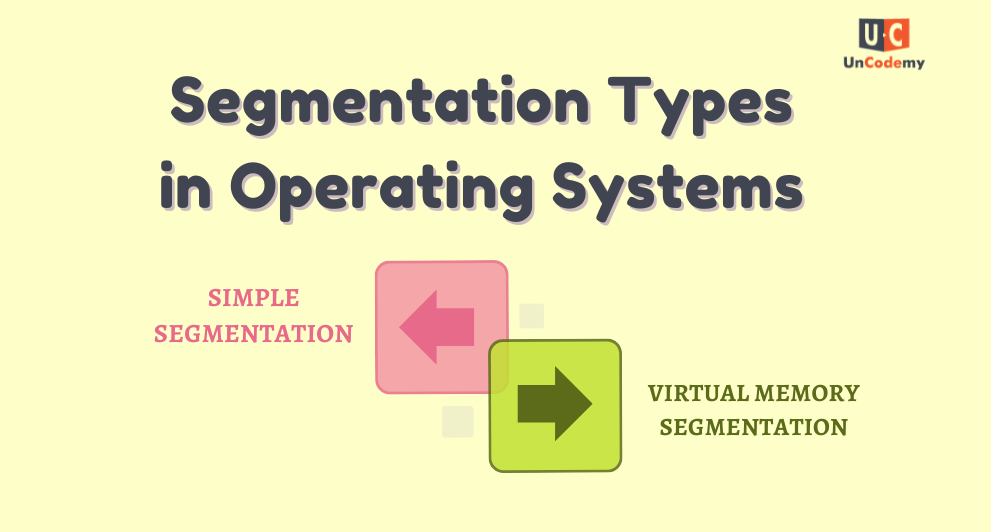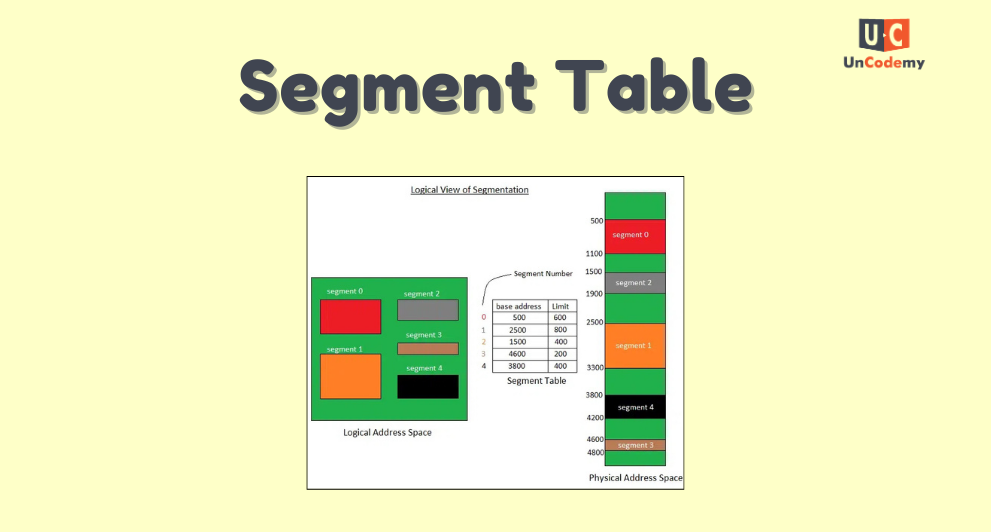The Ultimate Guide to Segmentation in Operating Systems

- Dynamic Memory Management
- Future of OS Memory Management
- Memory Allocation
- Memory Management
- Operating Systems
- OS Techniques
- Paging vs Segmentation
- Segmentation
- Virtual Memory
What is Segmentation?
Segmentation is a method used by operating systems to manage memory by dividing it into segments of different sizes. Each segment is a part of a program that can be handled separately. Unlike paging, which doesn’t reflect how a program is structured from the user’s perspective, segmentation keeps the logical division of the program intact.
In segmentation, it’s not necessary to store all segments in contiguous memory. Since there’s no need for internal partitioning, memory is allocated based on the actual needs of the program. The size of each segment depends on the role it plays in the program.
Why is Segmentation Needed?
Segmentation was introduced to address the limitations of paging. In paging, a program is broken down into fixed-size parts, which doesn’t take into account how different sections of the program are related. This means that to run a program, the CPU has to load many separate pages into memory, which can be inefficient. Segmentation, on the other hand, divides a program into logical segments, so related parts of the program can be grouped together and loaded as a single block, making the process more efficient.
By integrating file access methods with segmentation, operating systems achieve efficient data management, optimal memory usage, and enhanced performance, meeting diverse application needs.
Refer to the section on File Access Methods in Operating Systems
Types of Segmentation in Operating Systems:

1. Simple Segmentation: This method divides a program’s processes into smaller segments, which are placed in memory during execution. Unlike traditional segmentation, where all segments are stored next to each other, simple segmentation spreads these segments across different locations in memory. This helps optimize memory usage and improves system performance.
2. Virtual Memory Segmentation: This technique divides a program into several segments, but not all segments are divided at the same time. Whether virtual memory segmentation happens depends on the system’s needs and runtime conditions. This method helps manage memory more efficiently based on the program’s requirements.
Segmentation in Memory Management:
Segmentation in Memory Management is a technique used by operating systems to divide the memory into variable-sized blocks or segments based on the logical divisions of a program. Unlike paging, which breaks memory into fixed-size pages, segmentation allows each segment to be of a different size, depending on the needs of the program. This division helps in managing memory more effectively and logically, corresponding to the different parts of a program.
Key Points of Segmentation:
- Logical Division: A program is divided into segments, such as code, data, stack, and heap, each representing a specific aspect of the program.
- Code Segment: Contains the program’s instructions (executable code).
- Data Segment: Stores global and static variables.
- Stack Segment: Handles function calls, local variables, and control information.
- Heap Segment: Manages dynamic memory allocation (like objects created during runtime).
- Variable-sized Segments: Unlike paging, where memory is divided into fixed-size pages, segmentation uses segments of varying sizes, depending on the program’s requirements. This approach makes memory allocation more flexible and easier to manage.
- Segmentation Table: The operating system maintains a segment table to keep track of each segment’s base address (where it starts in memory) and its size. This table helps the OS locate and manage memory segments.
- Security and Protection: Since segments represent different parts of a program, the operating system can ensure that one segment cannot access or modify another segment, improving security and preventing accidental memory corruption.
- Ease of User Perspective: Segmentation allows the memory structure to be closer to how users view their program, dividing the program into meaningful parts, making it easier for users to manage their programs and memory.
What is a Segment Table?

In a segmented memory system, a segment table keeps track of the different parts of memory that a program uses. Each entry in the table corresponds to a specific segment of the program and stores details like the segment’s starting address and its size.
The CPU works with both the segment table and segment registers. When a program needs to access memory, the CPU uses the segment table entry to find the starting address and size of the segment it needs, ensuring it can locate and access the correct memory.
How Does Segmentation Work?
In segmentation, each segment is treated like a separate block of memory. When using the variable splitting method, a segment represents one block, and the details of each segment are stored in a separate table. This table has two parts: one part holds the length of the segment, and the other part shows where the segment starts in memory, helping to access subsequent addresses.
A segment can be a logical group of instructions, such as an array, symbol table, stack, local variables, subroutines, or functions. The process of managing these segments is called segmentation, and it helps organize and control memory more efficiently.
How Does Segmentation Work?
In segmentation, each segment is treated like a separate block of memory. When using the variable splitting method, a segment represents one block, and the details of each segment are stored in a separate table. This table has two parts: one part holds the length of the segment, and the other part shows where the segment starts in memory, helping to access subsequent addresses.
A segment can be a logical group of instructions, such as an array, symbol table, stack, local variables, subroutines, or functions. The process of managing these segments is called segmentation, and it helps organize and control memory more efficiently.
Advantages of Segmentation in Operating Systems:
1. Reduced Internal Fragmentation: Segmentation helps reduce internal fragmentation compared to fixed-size paging because segments are sized based on the actual needs of a process. However, internal fragmentation can still happen if a segment is allocated more memory than it needs.
2. Smaller Segment Table: The segment table takes up less memory compared to a page table in paging.
3. Improved CPU Utilization: Segmentation improves CPU efficiency because a complete module is loaded at once, making the process smoother.
4. User-Friendly Memory Structure: Segmentation makes the memory appear similar to how users think about it. Users can break their programs into modules, which can be treated as separate code blocks.
5. Customizable Segment Size: In segmentation, the user can specify the size of each segment, whereas in paging, the hardware decides the page size.
6. Data and Security Separation: Segmentation helps separate data from security operations, providing better memory organization.
7. Flexibility: Segmentation offers more flexibility than paging, as segments can have varying sizes, and processes can be designed with multiple segments, allowing for more precise memory allocation.
8. Sharing: Segmentation allows processes to share memory segments. This is useful for communication between processes or sharing code libraries.
9. Protection: Segmentation adds a level of protection by preventing one process from accessing or altering another process’s memory, enhancing security and system stability.
Disadvantages of Segmentation in Operating Systems:
1. External Fragmentation: As processes are loaded and removed, memory can be broken into smaller chunks, leading to external fragmentation. This is a key difference from paging, where external fragmentation is usually much lower.
2. Overhead: Maintaining a segment table for each process adds extra memory usage and can increase overhead.
3. Increased Access Time: Accessing memory can take longer because the CPU needs to perform two memory accesses: one for the segment table and another for the actual memory location.
4. Fragmentation: Segmentation can lead to external fragmentation, wasting memory and affecting performance.
5. Overhead in Managing Segment Tables: Using a segment table increases overhead, as each entry requires memory and accessing the table can slow down memory operations.
6. Complexity: Segmentation can be more complex to implement and manage compared to paging. Handling multiple segments for each process can be challenging, and the risk of segmentation faults increases.
Future Trends and Innovations in Segmentation:

Let’s explore the future developments and innovations in segmentation.
1. Hybrid Segmentation-Paging Approaches: An emerging trend is combining segmentation with paging to get the best of both worlds. Hybrid segmentation-paging approaches aim to blend the flexibility of segmentation with the efficient memory management of paging, leading to better performance and resource usage.
2. Adaptive Segment Sizing Algorithms: Traditional segmentation often uses fixed-size segments, which may not be ideal for varying workload demands. Future advancements may focus on creating adaptive algorithms that can adjust segment sizes based on the needs of the application and available memory. These algorithms would help allocate memory more efficiently, adapting to changes in workload and system conditions.
3. Dynamic Segment Allocation and Management: In dynamic memory systems, segment allocation and management need to be flexible and responsive to changes in the system. Future developments may focus on dynamic allocation methods that prioritize important processes or adjust segment boundaries in real-time to optimize memory use. Techniques like memory ballooning or hot-swapping could be integrated with segmentation for better flexibility and scalability.
4. Hardware Support for Segmentation: As hardware evolves, there could be innovations aimed at improving segmentation performance. New processors and memory systems might include specialized hardware to speed up segment lookup and management, reducing overhead and latency. Integrating segmentation-aware features directly into CPU architectures could improve memory access and system responsiveness.
5. Segmentation in Emerging Computing Paradigms: With the growth of edge computing, IoT (Internet of Things), and distributed systems, segmentation could become essential for efficient resource allocation and isolation across diverse environments. Innovations in segmentation tailored for edge devices, embedded systems, and distributed networks could improve resource sharing, security, and reliability.
6. Machine Learning and AI-driven Segmentation Optimization: Machine learning and AI may be used to optimize segmentation by analyzing workload patterns and adjusting segment parameters for the best performance. AI models could predict memory usage and application behavior, allowing segmentation systems to adaptively manage memory allocation in real-time for better efficiency and performance.
Conclusion
While segmentation offers many advantages, it also comes with some challenges. Managing segments of varying sizes can be tricky, and segmentation might need to be enhanced to handle the complexities of modern, dynamically created memory structures. As a result, many modern operating systems combine segmentation with paging or use other memory management techniques to improve memory organization and security. This hybrid approach helps balance the strengths of both methods for better performance and efficiency.
FAQs: –
1. Difference between Paging and Segmentation
Paging is a memory management method that divides memory into equal, fixed-size blocks. These blocks are called pages, and they are used for non-contiguous memory allocation.
Segmentation, on the other hand, also allocates non-contiguous memory but divides it into segments of varying sizes, based on the needs of the process, rather than fixed sizes like paging.
2. What is an Example of a Segmentation Problem?
A segmentation problem could be when a company categorizes its customers into different segments, like residential and commercial, each with its own set of conditions and rates.
This type of segmentation can lead to issues when trying to manage these distinct groups effectively.
3. Why is Segmentation Used in OS?
Segmentation improves CPU performance by loading entire segments at once.
It makes memory management more efficient and helps the operating system organize memory better.
It also aligns with how users view memory, allowing programs to be divided into smaller, manageable modules.
4. What is Segmentation?
Segmentation in operating systems refers to dividing the primary memory into smaller blocks, called segments, to organize and manage memory more efficiently.
5. Why is Segmentation Used in OS?
Segmentation is used to improve the overall performance of the operating system.
By dividing memory into different segments, it helps optimize how the system allocates resources and makes memory management more effective.





























